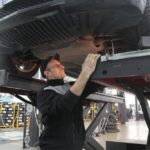In the fast-paced world of emergency medical services (EMS), time is critical, and efficiency is paramount. Traditional EMS carts have long been an essential part of emergency response, but they have their limitations. They can be bulky, difficult to maneuver, and require a significant amount of physical effort from EMS personnel. Enter the electric EMS cart a revolutionary upgrade that’s transforming the way emergency teams operate. This article explores why electric EMS carts are a game-changer for emergency response teams and how they are improving speed, efficiency, and safety.
Enhanced Mobility in Tight Spaces
One of the most significant advantages of an electric EMS cart is its enhanced mobility, especially in tight spaces. Traditional hand-pushed carts can be cumbersome, particularly in environments such as crowded hospital corridors, busy city streets, or packed event venues. With an electric EMS cart, however, navigating these spaces becomes much easier.
Electric carts are typically more compact and streamlined, allowing them to glide smoothly through narrow hallways or densely packed areas. This increased mobility means that EMS teams can reach patients more quickly, even in locations with limited access. Whether responding to a call at a crowded sports stadium or maneuvering through a bustling downtown area, the electric cart’s nimble design ensures that medical personnel can access patients and provide timely care.
Speed and Efficiency in Emergency Situations
Speed is of the essence in emergency medical services, and electric EMS carts excel in providing quicker response times compared to their traditional counterparts. The electric motors in these carts offer faster acceleration, reducing the time it takes to transport medical equipment and personnel to the scene of an emergency.
Moreover, EMS personnel no longer need to exert physical energy pushing heavy carts for long distances, which can be both tiring and time-consuming. With the help of an electric motor, personnel can focus more on patient care and less on the physical demands of moving equipment. This boost in efficiency directly translates to faster response times, which can make a crucial difference in life-or-death situations. By cutting down the time spent on physical labor, EMS teams can allocate more resources to helping the patient.
Reduced Physical Strain on EMS Personnel
Another significant benefit of electric EMS carts is the reduction in physical strain on EMS personnel. Traditional carts can be physically demanding to push, especially over long distances or uneven terrain. This puts strain on workers, increasing the risk of injury and fatigue, which could ultimately lead to burnout.
Electric carts provide an ergonomic solution, as they assist with the pushing and reduce the manual effort required. This not only helps prevent injuries but also allows EMS workers to maintain their energy and focus throughout their shifts. With less physical strain, EMS personnel are better able to perform their duties and provide quality care without the concern of physical exhaustion. Over time, this can lead to better job satisfaction and a healthier workforce.
Environmentally Friendly and Cost-Effective
In addition to their efficiency and mobility, electric EMS carts are also environmentally friendly and cost-effective. Traditional EMS carts often rely on fuel-powered engines, contributing to harmful emissions and noise pollution in busy urban areas. Electric carts, on the other hand, run on batteries, meaning they produce zero emissions and operate quietly. This makes them an environmentally responsible choice, aligning with the growing trend of sustainability in public services.
Moreover, the long-term cost savings of electric carts are significant. While the initial investment in electric carts may be higher than that of traditional models, the savings on fuel, maintenance, and repairs over time can offset the cost. Electric motors require less maintenance compared to gasoline-powered engines, leading to lower operating costs. Furthermore, the absence of fuel consumption further reduces the operational expenses of EMS teams, freeing up funds for other essential needs.
Technological Advancements in Electric EMS Carts
As with many modern innovations, electric EMS carts have benefited from advancements in technology. Many of today’s electric carts are equipped with cutting-edge features designed to improve efficiency and enhance patient care. Some electric carts are now equipped with GPS systems, real-time tracking, diagnostic tools, and communication systems, allowing for better coordination among EMS teams and dispatchers.
These technological features help ensure that emergency services are as efficient as possible. By providing real-time data and updates on the cart’s location, medical teams can respond faster to emergencies. GPS tracking also ensures that emergency services are optimized, helping teams avoid delays and route traffic efficiently. The integration of technology into electric EMS carts adds another layer of effectiveness, allowing EMS personnel to operate with greater precision and ease.
Positive Impact on Patient Care
The ultimate goal of any EMS operation is to provide the best care to patients in need. Electric EMS carts directly contribute to improving patient care by increasing the speed at which patients are transported and reducing the physical strain on medical staff. The quicker response times provided by electric carts mean that EMS teams can reach patients faster, potentially saving lives.
Additionally, because EMS teams are less fatigued, they can focus on providing high-quality care during transport, ensuring that patients receive the necessary medical attention while en route to medical facilities. The efficiency and speed of electric carts can make a significant difference in the outcome of emergency situations, ultimately improving patient satisfaction and survival rates.
The Future of Electric EMS Carts
As technology continues to evolve, electric EMS carts are expected to become an even more integral part of emergency medical services. Future innovations may further improve the efficiency, capacity, and range of electric carts, making them even more valuable in critical situations. As electric vehicle technology advances, we can expect even longer battery life, faster charging times, and greater durability.
Electric EMS carts have already shown great promise in transforming the way emergency teams operate, and their role in EMS fleets is only set to grow in the coming years. With ongoing advancements in technology and increased adoption by EMS teams worldwide, the future of emergency medical response looks brighter, faster, and more efficient.
Conclusion
Electric EMS carts are revolutionizing the way emergency teams respond to crises. With their ability to navigate tight spaces, improve response times, reduce physical strain, and contribute to a greener environment, electric carts are quickly becoming an essential tool for modern EMS teams. As technology continues to evolve, these carts will only become more powerful, efficient, and reliable. By embracing electric carts, emergency medical services are not only improving their operational efficiency but also enhancing patient care and the well-being of their personnel. The future of EMS response is electric.







